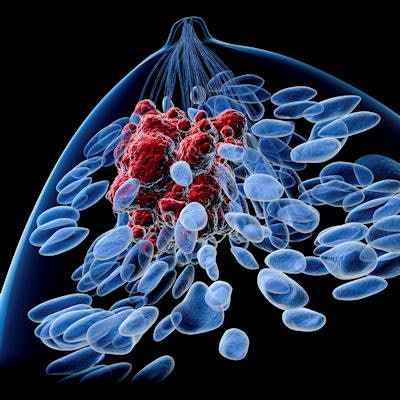
Deep-learning algorithms can detect axillary lymph node metastasis on multiparametric MRI exams of breast cancer patients with a high level of accuracy, according to research published online July 13 in Clinical Breast Cancer.
Researchers from the Albert Einstein College of Medicine in New York City trained five different deep-learning algorithms to detect nodal metastasis in patients before neoadjuvant chemotherapy. In testing, the best-performing model yielded 88.5% accuracy and was significantly more accurate than two radiologists.
"This approach has the potential to ultimately obviate unnecessary sentinel biopsy and axillary dissection and allow for monitoring of treatment effects on the node longitudinally with time, providing a powerful noninvasive method to guide neoadjuvant chemotherapy," wrote first author Thomas Ren, senior author Timothy Duong, PhD, and colleagues.
Although it's essential to accurately assess the axillary lymph nodes to determine prognosis and plan treatment, current radiological staging of nodal metastasis has poor accuracy, according to the researchers.
In an effort to apply AI technology to this task, they first gathered 238 axillary lymph nodes from 56 breast cancer patients who had both FDG-PET/CT and bilateral breast MRI data. FDG-PET results served as ground truth for the study. Of the 238 axillary lymph nodes, 65 were abnormal and 173 were normal based on FDG-PET results.
The researchers then developed a variety of deep-learning algorithms to detect nodal metastasis on multiparametric MRI. The convolutional neural networks (CNNs) were trained using 2D pre- and postcontrast T1-weighted MRI, T2-weighted MRI, dynamic contrast-enhanced (DCE) MRI, T1 + T2-weighted MRI, or DCE + T2-weighted MRI exams. Three-fold cross-validation was performed.
One breast radiologist with over 20 years of experience and a third-year resident also independently classified nodes as either normal or abnormal on the MRI images. Their results were then compared with the deep-learning algorithms.
The researchers found that all models yielded similar performance, with the algorithm trained using both T1- and T2-weighted images achieving the best results.
| Performance of AI models for identifying axillary lymph node metastasis | ||||||
| Radiologists | CNN (T1) | CNN (T2) | CNN (DCE) | CNN (DCE+T2) | CNN (T1+T2) | |
| Accuracy | 65.8% | 87.5% | 86.1% | 87% | 88% | 88.5% |
| Area under the curve | n/a | 0.832 | 0.804 | 0.844 | 0.880 | 0.882 |
All models performed better than radiologists in detecting nodal metastasis, according to the researchers. They also deemed T1-weighted MRI to be more informative than T2-weighted MRI for detecting metastatic nodes.
"This is likely because [T1-weighted] MRI was sensitive to contrast agent leakages in disease nodes," the researchers wrote. "T2-[weighted] MRI has been shown to have unclear tumor boundaries causing [region of interest] delineation difficulties and obscuration of lymph nodes near arteries due to motion."
Noting that the CNN trained using both T1 and T2-weighted images achieved the best results, the researchers determined that T2 images do provide complementary information, however.
The authors concluded that a prospective, multicenter study with a large sample size and validation with pathologic ground truth is now needed in order to demonstrate generalizability for the algorithms.



















